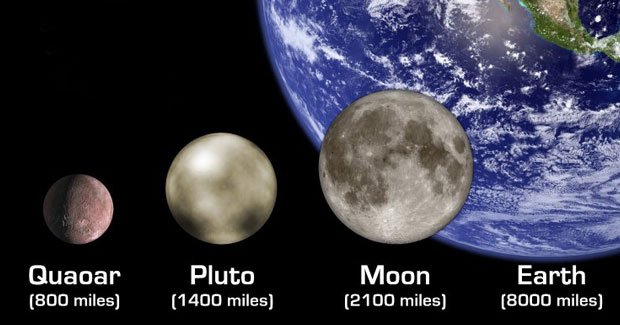Dwarf planets accumulate in outer Solar System

PLUTO’S STATUS MAY TAKE a further hit, say Australian astronomers, if around 50 neighbouring space objects join the ranks of the dwarf planets.
Pluto was demoted to ‘dwarf planet’ in a decision by the International Astronomical Union (IAU) in 2006. This decision – which was unpopular with the general public – was based on the discovery of many objects which were a similar size or larger than Pluto in a zone of the Solar System known as the Kuiper Belt.
Other dwarf planets include Ceres, the largest asteroid in the rock-strewn belt between Mars and Jupiter, and four Kuiper Belt objects: Eris, Makemake, Haumea and Quaoar.
Now, astronomers Charley Lineweaver and Marc Norman, from the Australian National University in Canberra, say the definition of what it means to be a dwarf planet should be revised to include many smaller objects too.
“Small Solar System objects are irregularly shaped, like potatoes,” Charley says. “If an object is large enough that its self-gravity has made it round, then it should be classified as a dwarf planet.”
Defining dwarf planets
The IAU’s definition decrees that a dwarf planet must orbit the Sun, must not be a satellite of another planet, must not have cleared its orbit of debris (like larger planets do) and it must be of sufficient mass to assume a nearly round shape. They also state that dwarf planets should be of a certain brightness, which is only possible with objects with a radius of more than 420 km.
Charley and Marc now argue that the radius which defines a dwarf planet should instead be from 200–300 km, depending on whether the object is made of ice or rock.
They base their smaller radius on the limit at which objects naturally form a spherical rather than potato-like shape because of “self-gravity”. Icy objects less than 200 km (or rocky objects less than 300 km) across are likely to be potato shapes, while objects larger than this are spherical.
This is because as an object in space becomes larger, the effects of its own gravity become more important in dictating the final shape. They call this limit the ‘potato radius’, and the results were published recently in the Proceedings of the 9th Australian Space Science Conference.
Arbitrary boundary
“The boundary between dwarf planets and small Solar System bodies is somewhat arbitrary, but is based on…how round an object is,” Charley told Australian Geographic. “In science it’s our job to figure out [the truth],” and we shouldn’t ignore the fact that many smaller objects in the vicinity of Pluto also resemble dwarf planets, just because we don’t want to upset the status quo, he says.
Astronomer Simon O’Toole at the Anglo-Australian Observatory in Sydney says the recommendations are a “natural progression and a nice, simple model”.
“It’s nice to have a physical approach as to what is a dwarf planet and what is not,” says Simon, who agrees that the IAU’s definition is arbitrary. “I have no problem with there being hundreds of dwarf planets eventually,” he says.

